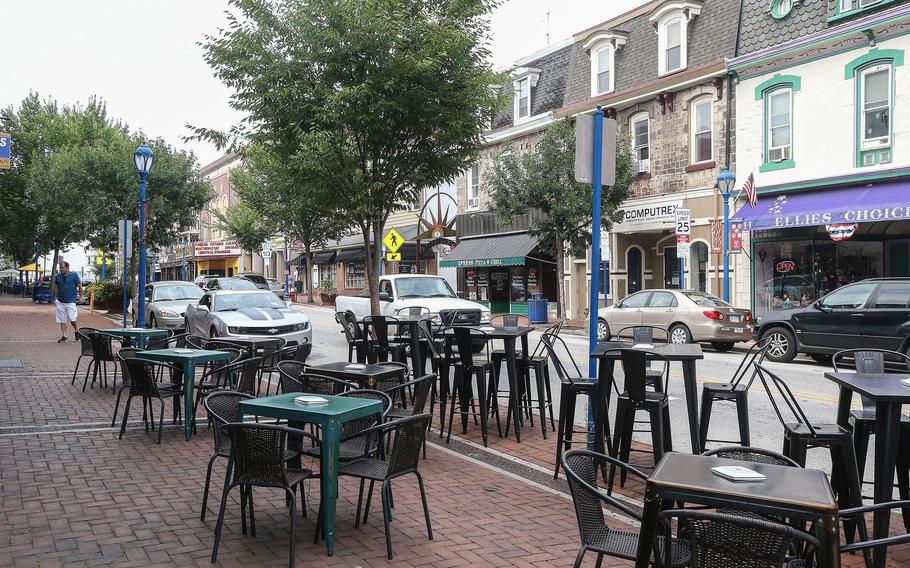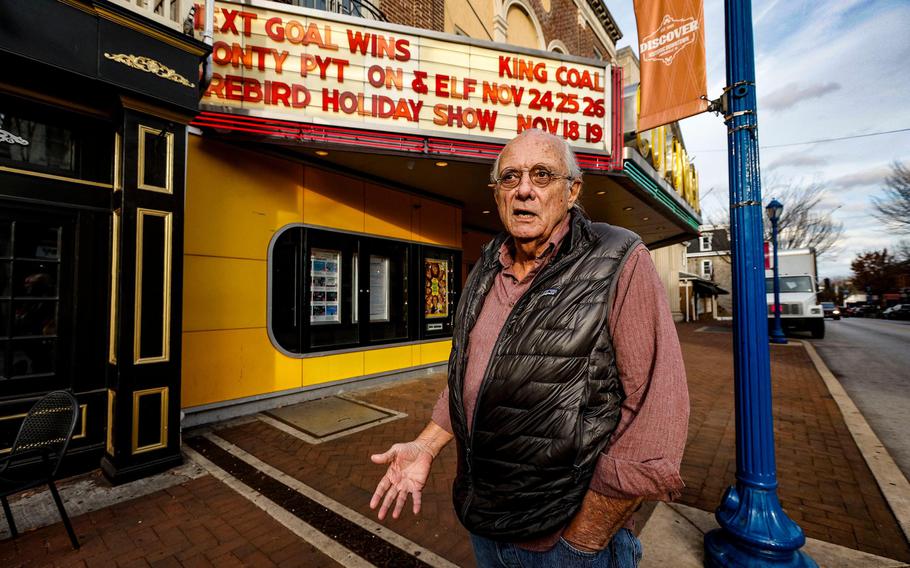
Outdoor tables on Bridge Street in Phoenixville, Pa. Some business owners and residents are frustrated with the town’s popular outdoor drinking and dining series PXV Inside Out: Born from pandemic lockdowns, each weekend between May and October, the Chester County borough closes off two blocks along Bridge Street, its main business strip, for pedestrians to eat, drink and shop, free from cars. (Steven M. Falk, The Philadelphia Inquirer/TNS)
When Barry Cassidy sees thousands of people strolling along Phoenixville’s main business corridor, he should be elated.
The 74-year-old was once the Chester County borough’s “main street manager,” helping the struggling town get back on its feet by staging attention-grabbing events and injecting millions of grant dollars into downtown properties.
Instead, as Phoenixville caps off another season of its popular outdoor drinking and dining series PXV Inside Out, Cassidy and a handful of longtime business owners are feeling the growing pains of a boom that, ironically, they helped usher in.
“When we started the revitalization we went with an arts-and-entertainment economic development strategy,” Cassidy said. “It’s changed now to a more alcohol-based strategy.”
What was once a former steel town plagued by deindustrialization is now a regional hot spot for food and entertainment, attracting both young professionals and empty-nesters.
With property values ballooning and the addition of almost 5,000 new residents since Cassidy arrived 20 years ago, Phoenixville no longer has the need for a main street manager.
But Cassidy, over a decade after his departure from the post, still has strong feelings about his former enterprise — even from his home in Downingtown; lately, those are directed at Inside Out.
Born from pandemic lockdowns, each weekend between May and October, the borough closes off two blocks along its main business strip, Bridge Street, for pedestrians to eat, drink and shop, free from cars.
Phoenixville leaders say residents and businesses alike widely enjoy the series. But as Inside Out wraps up its fourth year, Cassidy and a band of local business owners would rather the borough nix the program, or seriously retool it.

Barry Cassidy, who was once Phoenixville, Pa.’s main street manager, outside of the Colonial Theatre, which he helped redevelop in the early 2000s. Cassidy is among those frustrated with the road closures along Bridge Street during PXV Inside Out. (Steven M. Falk, The Philadelphia Inquirer/TNS)
Fed up
Several weeks after Inside Out wrapped for the season, Cassidy and nine local entrepreneurs filed into the back room of Molly Maguire’s Irish Restaurant & Pub in the borough’s downtown.
Some shop owners let out frustrations they’d held all summer.
Their disgruntlement lay mainly with the road closures along the 100 and 200 blocks of Bridge Street, which some said disrupted typical shopping patterns and made parking for longtime customers — especially older and out-of-town residents — a major headache.
Cassidy, arms crossed over his Patagonia puffer vest, didn’t stop the venting. The Pittsburgh native has long stood up for the underdog, first organizing labor unions in the 1970s, later aiding the revival of South Street in Philadelphia.
His reputation, or at least his face, is familiar about town.
In one of the pub’s secluded dining rooms, an old photograph of Cassidy hangs on the wall, illuminated by a single lamp. When it was hung, Cassidy jokes, he requested that it be connected to a generator in case the power ever went out.
“I’ve lived in this town my whole life — I watched it in the ‘70s thrive, in the early ‘80s die,” said Theresa Brewer, who owns TC House of Style, a boutique on Bridge Street.
She motioned to Cassidy. “I watched this gentleman help bring this town back.”
Today, Brewer said she’d love to have her 93-year-old mother stop by her shop on the weekend, but she can’t park close to her store when Bridge Street is closed.
A little over 130 parking spots are unavailable during the closures. To make up for this, the borough offers over 700 spaces available in satellite lots within a quarter- to half-mile radius.
There was also frustration with the borough’s lax open-container policy during Inside Out, which some businesses said had brought booze-fueled riffraff to the steps of their shops.
“Our foot traffic has declined,” said Tom Duffy, owner of Phoenixville House of Jerky on Bridge Street. “When the street is closed, the blinders are on, it’s the booze crowd.”
If it were up to Duffy, the borough would return to shutdowns only on “First Fridays.”
The monthly outdoor concert series, started under Cassidy, makes music the main draw. Molly Maguire’s owner Connor Cummins, eager to liven up his adopted home, used to foot the bill for the bands, before fees became unfeasible.
And on those Fridays, as well as for the borough’s beloved street festivals, road closures only lasted a day — not the whole weekend.
For Duffy, that made events rarer, and more special.
“Now all it is a closed street,” he said, sliding back in his chair.
Differing perspectives
Phoenixville officials say they respect all opinions, but that these voices don’t represent all businesses.
Peter Urscheler, the borough’s mayor, says that since Inside Out began, its popularity has only grown.
“What we’ve seen is a diversity coming into the community,” Urscheler said. “We see residents coming down and walking into downtown; you see families, you see pets, lots of dogs, baby strollers. And you start to see people who are visiting our community from out of town, because this has become something that’s very unique.”
Several years after the savvy millennial business consultant took office, the sudden impact of COVID-19 meant borough leaders had to reimagine downtown for open-air living.
When the series launched in 2020, they initially closed off Bridge Street for a whopping four days per week. Today, the shortened program lasts from 2 p.m. on Friday to 7 a.m. on Monday. This past year, Urscheler said the event drew between 3,000 to 7,500 guests each weekend, sometimes more.
For business owner Aaron Weitzenkorn, Inside Out has been anything but disruptive.
In fact, Weitzenkorn said he’s had to keep his Bridge Street men’s clothing shop, Weitzenkorns, open an extra hour on the weekends to accommodate the influx of customers.
“There’s nights during the closure where we literally cannot close the door until 9:30, almost 10 o’clock, because we’ve got people in and out,” said Weitzenkorn, whose business may be the second-oldest independent clothing retailer in the country. “My dad always said, ‘Any time that door opens, it’s a great thing.’“
Residents’ opinions are equally varied.
For those like Katherine Gascon, a 28-year-old who moved to Phoenixville during the pandemic, the series represents what’s made the borough attractive to a younger crowd.
“I was sad when it was shortened this year, and I’m in support of it being every weekend,” Gascon said during the public comment portion of a recent borough council meeting.
“I find that I’m part of the morning crowd that goes out, gets bagels and coffee, and also part of the newfangled evening crowd that is out at midnight,” she continued. “When I’m out on the weekends, I’ve found it easier to walk to shops.”
Jean Krack, the borough’s manager, said that as leaders plan next year’s event schedule, he’s open-minded to the community’s concerns.
Krack said the borough was considering limiting its open-container policy after 9 p.m., as well as eliminating the drink policy on side roads like Main Street, a restaurant-heavy strip perpendicular to the main Bridge Street closure, but no plans are final.
Some complaints, Krack said, were simply the growing pains of a thriving borough. In 2000, the borough’s population was 14,788, according to U.S. Census data. Today, it’s nearing 20,000.
Of the thousands of new residents, Krack said: “That would be a great problem for a business to have.”
Golden years
When Cassidy arrived in 2003, the borough was reeling from the closure of the Phoenixville Steel Co. in 1987; almost 40 storefronts were vacant, Cassidy said, and open-air drug deals were common along Bridge Street.
By the time he left Phoenixville’s Main Street Community Development Corporation in 2010, Cassidy said his team had secured around $9 million in grants for its development. Projects varied, from adding trees and new streetlights, to offering residents on the borough’s North Side $5,000 each to rehabilitate dilapidated homes.
Paramount, he said, was Colonial Theatre’s refurbishment. The century-old opera house — minted into science-fiction film history after being featured in 1958’s The Blob — was once on the brink of shuttering.
Cassidy knew something was working the first time he saw 500 people downtown in one place; he’d organized a Beatlemania concert on the roof of a bicycle shop, the band recreating the Fab Four’s iconic 1969 Abbey Road performance.
Visitors can still find live music during Inside Out. However, Cassidy worries those creative “golden years” have passed, and that its current leaders aren’t receptive to the concerns of his friends.
“Change is hard, if you’re accustomed to something and there’s a new vision,” Krack, the borough manager, said. “All sides have to listen — you don’t want one overpowering the other.”